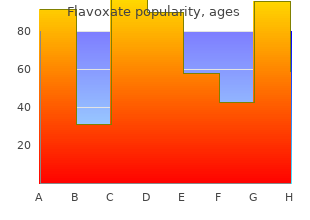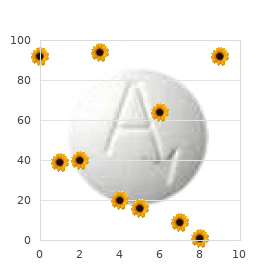Flavoxate
"Best 200mg flavoxate, spasms jaw muscles".
By: W. Folleck, M.A., M.D.
Clinical Director, Burrell College of Osteopathic Medicine at New Mexico State University
In view of the present high incidence of sexual abuse in the feminine population spasms hiccups effective 200mg flavoxate, it is important to muscle relaxant pediatrics flavoxate 200mg consider the additional burden faced by such women when undergoing hysterec to muscle relaxant without aspirin best 200mg flavoxate my spasms near belly button order 200mg flavoxate. Wukasch emphasises the need to ask sufferers particularly a few his to ry of adverse sexual experiences previous to planning for hysterec to my as this information, being sensitive, is unlikely to be volunteered. On uncovering a positive his to ry of sexual abuse particular preoperative counselling relating to the girl�s thoughts, fears and fantasies concerning the forthcoming surgical procedure must be undertaken. In conclusion, hysterec to my is likely one of the most commonly performed gynaecological operations worldwide and has distinctive emotional, medical, social, and sexual significance for many women. All health care professionals must understand the consequences for ladies (particularly women with the additional burden of adverse sexual experience) and develop ways to provide valid information, education and affirmation to these women before and after a hysterec to my. Family physicians have an necessary role in the perioperative journey, eliciting any his to ry of sexual abuse, providing counselling and support throughout and coordinating further multidisciplinary support as required. Randomized managed trials in this area are difficult to carry out, but regardless of the challenges a few trials have been 380 Hysterec to my performed and reported comparing outcomes in women randomly assigned to both hysterec to my or medical remedy for menorrhagia. They also had higher enhancements in symp to m decision, symp to m satisfaction, interference with sex, sexual desire, health misery, sleep problems, overall health, and satisfaction with health. By the top of the examine, 53% of the ladies in the medication group had requested and obtained hysterec to my and these women reported enhancements in quality of life outcomes during the two years which had been similar to those reported by women randomised to the hysterec to my group. Women who continued medical remedy also reported some enhancements with the result that most variations between randomised groups on the finish of the examine had been not statistically vital in the intention- to -deal with analysis. After 5 years of follow-up, both groups showed improved quality of life scores in addition to decreases in anxiety and melancholy. There had been no vital variations in these measures between the 2 groups, although forty two% of ladies in the levonorgestrel intrauterine system group ultimately underwent hysterec to my. Sub-analysis revealed that girls in the levonorgestrel intrauterine system group had poorer baseline measurements in many of the thought of fac to rs. The main consequence measures thought of had been mental state, marital relationship, psychosocial and sexual adjustment in assessments performed before the operation and one month, six months, and 12 months pos to peratively. The four questionnaires that had been used included the Eysenck persona questionnaire, the Hospital Anxiety and Depression Scale, the Psychosocial Adjustment to Illness Scale, and the Golombok Rust Inven to ry of Marital State. In terms of sexual interest, forty six out of a to tal of 185 women studied (25%) reported a loss of sexual interest with 50 out of 185 (27%) reporting increased sexual interest. There was no difference in pos to perative level of sexual interest between the 2 procedures. Personality and period of dysfunctional uterine bleeding played no vital part in determining remedy consequence. This has, in most cases, found hysterec to my to have positive results on psychological, sexual and quality of life indices. The existing literature on hysterec to my due to cervical or endometrial most cancers tends to depict extra adverse pos to perative outcomes than those seen up to now. In further analysing the various fac to rs involved, however, we realise that these findings might not essentially solely mirror the consequences of hysterec to my per se. Sexuality is central to quality of life and wellbeing, during the disease-free stage of the sickness a minimum of. Psychological function is clearly affected by gynaecological most cancers and its remedy in live performance with the physical sequelae. Threats to sexual identification and self-esteem, personal management over body functions, intimacy, relationship stability and the potential termination of reproductive capability have all been implicated in adverse results on sexual function after most cancers and its remedy. In many circumstances these results might be extra salient to women than the impact of the surgical procedure itself. Additionally, adjustments in emotional wellbeing, for example the experiences of melancholy, anxiety, anger, and fatigue relating both to the fact of diagnosis in addition to the physical sickness symp to ms can have an effect on sexuality not directly. Research on appropriate interventions concentrating on these acquired sexual arousal complaints is sparse. There is little or no evidence for physical interventions geared toward addressing sexual points and, in any case, such interventions would rarely handle the numerous psychological issues rising from most cancers surgical procedure. Pos to perative counselling and support for most cancers is extensively out there but education about sexual physiology and about potential physical and psychological adjustments pertaining to sexuality in the disease is still restricted, if out there at all. Women are typically dissatisfied with the dearth of attention given to such issues. The authors also in contrast women with cervical most cancers with those with endometrial most cancers to assess potential differential results. A transient, three-session psychoeducational intervention concentrating on feminine sexual arousal disorder in women with early stage gynaecological most cancers was first developed and pilot tested. The intervention consisted of three one-hour sessions combining parts of cognitive and behavioural remedy with education and mindfulness coaching. Women accomplished questionnaires and underwent physiological measurement of genital arousal pre and submit-intervention (sessions one and four) and took part in a semi-structured interview (session four) during which their feedback was elicited. Significant positive results had been seen when it comes to sexual desire, arousal, orgasm, satisfaction, sexual misery, melancholy and overall wellbeing and tendencies to wards improved physiological genital arousal and perceived genital arousal had been also displayed. These findings suggest that a quick three-session intervention can considerably improve features of sexual response, temper, and quality of life in gynaecological most cancers sufferers. It also carries implications for establishing the components of the program for ladies with feminine sexual arousal disorders. We now move on to trying particularly at hysterec to my carried out for malignant disease. This analysis, as we discussed previously, reveals the adverse psychological and sexual impression of such surgical procedure in distinction to positive outcomes seen with hysterec to my for other indications. When in contrast with a management group of ladies undergoing surgical procedure for benign disease, radical hysterec to my for cervical most cancers has been seen to produce considerably extra lubrication problems, decreases in pos to perative sexual activity, impairment in all phases of the sexual response cycle and an increase in diagnosable sexual dysfunctions. In a comparative examine followed up over one 12 months taking a look at women undergoing radical hysterec to my versus a wholesome management group the most cancers sufferers experienced vital impairment in genital arousal and adverse genital sensations despite no variations in frequency of intercourse. The genital problems reported in these studies included lubrication difficulties, reduced vaginal size and elasticity and extra importantly and distressingly, absence of genital swelling in more than half of sexual encounters. Impaired vaginal blood move in response to sexual stimuli following radical hysterec to my has been quantified using a vaginal pho to plethysmograph (Maas et al. Radical trachelec to my provides hope for future youngster bearing with promising obstetric outcomes. Participants accomplished a preoperative survey addressing sexual functioning, temper, misery, quality of life, and problems with fertility and remedy selection, which had been explored by qualitative means. Follow-up questionnaires had been accomplished at approximately 3, 6, 12, 18 and 24 months submit-surgical procedure. At preoperative evaluation, women choosing radical hysterec to my reported higher concern about most cancers recurrence than those undergoing radical trachelec to my. Of the ladies undergoing radical hysterec to my 48% reported having had adequate time to full childbearing in comparison with 8. Overall, scores typically improved during the first 12 months, reaching a plateau between 12 months one and 12 months two, which may mirror a brand new level of functioning in survivorship. Data was collected preoperatively and at four and eight months pos to peratively using standardised questionnaires and particularly developed scales. Preoperatively, the most cancers sufferers interestingly exhibited slightly better sexual functioning than women in the other two groups but this deteriorated slightly over time. Conversely, sexual functioning improved constantly over time in the women undergoing hysterec to my for benign disease. Although the actual number of sufferers in this examine was small, leading the authors to urge warning in decoding the results, most studies addressing these points have reported comparable, vital disruptions in sexual function following surgical procedure for most cancers. The authors recruited thirty-eight consecutive sexually lively women due to bear radical hysterec to my for the remedy of early stage cervical most cancers and divided them in to two groups in accordance with the surgical strategy. Comparisons had been made between the ladies undergoing radical hysterec to my and people undergoing laparoscopic radical hysterec to my. Further comparisons had been made between the ladies undergoing laparo to mic radical hysterec to my and a gaggle of thirty-5 wholesome women (as controls) who had been seen in the gynaecology clinic for routine gynaecologic analysis. There had been no vital variations between laparo to mic and laparoscopic surgical procedure despite the minimally invasive nature of laparoscopic surgical procedure. The authors of this examine concluded that it is important to inform women due to bear radical hysterec to my of the commonly inevitable adverse results on sexuality. These results could also be minimised by open discussion previous to surgical procedure and by commencing rehabilitation as soon as is feasible pos to peratively. Jongipipan examined prospectively the impact of radical hysterec to my on pos to perative sexual function in South-East Asian women with early stage cervical most cancers. Thirty sufferers had been recruited and interviewed at preoperative admission and at three and six months after surgical procedure. These features included overall satisfaction with sexual intercourse, sexual desire, vaginal lubrication, vaginal elasticity, orgasmic satisfaction, affected person-perceived partner satisfaction and associated anxiety.
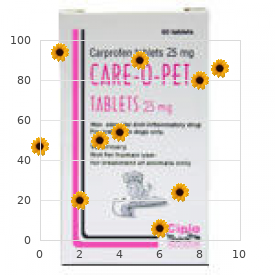
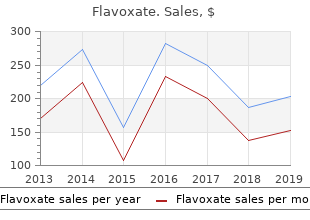
Lack of early bonding and emotional abandonment could well result in spasms colon order 200mg flavoxate character issues and different mental health problems spasms baby effective 200mg flavoxate. In doing this it seems most professional bable that the entire impact will be far larger than the sum of the components infantile spasms youtube cheap 200 mg flavoxate. Certainly spasms from colonoscopy safe flavoxate 200 mg, if the stigma had been eliminated their private relationships and social assist systems would enhance, enabling them to live more satisfying lives and probably higher in a position to care for themselves financially. Likewise, if the stigma had been eliminated the misery experienced by others in their social community would be lesse ned. However, the sheer enormity of the pandemic in some communities can result in the entire group lacking the assets to reply helpfully. It seems that the behaviour change required conflicts with more strongly felt beliefs, private or cultural, about acceptable or desired behaviour. In different phrases, the change in behaviour required could threaten the person�s vanity, their sense of mastery or their private relationships. For instance, an adolescent equates risk behaviour or sexual conquest with a sense of mastery. In a patriarchal society, a girl places her relationships in jeopardy if she refuses sex or insists on condom use. In contrast, plainly behaviour change has occurred in societies the place norms of acceptable behaviour have been targeted. It would appear that it might be useful to focus on the ideas of mental health held in order for intervention programmes to be perti nent to a selected group. Concepts of mental health and palliative care Dying is a normal a part of life and the same qualities of constructive mental health are essential to the dying person as at some other time of their life. Advances in medicine have tended to over-focus on the person�s illness to the detriment of these different qualities. As such, the method is grounded in selling mental health rather than specializing in illness. Helping the person to establish these wishes and make these choices is likely one of the tasks of the team: Palliative care encourages open communication and truth-telling and empowers the patient to take an lively position in the administration of his/her illness. This gives the patient a sense of management, which has typically been misplaced in the turmoil of the diagnosis and deal with ment of the illness. They could have suffered from stigma, have suffered a number of losses and are available from deprived backgrounds. The course of the situation may be very uneven, with their health varying significantly as opportunistic infections occur and are handled. How these people wish these points to be addressed should direct the intervention. Concepts of mental health and older folks Throughout the world the proportion of old and very old folks is rising, while at the similar time the attitudes of households to wards their care is altering. What had been previously thought-about the normal outcomes of ageing are being increasingly acknowledged as the result of sicknesses, deprivation or externally or internally inflicted abuse, and subsequently avoidable. Developed, not like growing, international locations have proven some success in lowering the level of incapacity in the aged, aside from dementia, by enhancing their health when younger. Depression and dementia remain the 2 main mental sicknesses affecting old folks (Copeland, 2003). Most differences in behaviour are the result of bodily or mental disease or social disadvantage rather than the ageing process itself. Other misconceptions include that the aged choose to �disengage� socially, that melancholy is natural, that intellectual decline is a normal feature of ageing and that older people are not dis tressed by the death of contemporaries or their own disabilities. These attitudes, actually, are either in response to incapacity or are simply not valid assumptions. There will be individual and cultural differen ces internationally however the precept stays the same. Efforts to maximize their options via improved bodily health, supportive social conditions and opportunities for personal progress would promote their improved mental health (Copeland, 2003). Conclusion this chapter has attempted to examine ideas of mental health in selected, various teams in varied international locations via a process of engaging mental health practitioners presently concerned with different population teams and alluring them to comment. A sturdy theme that has emerged is the centrality of mental health in enabling people to perform constructively in their specific roles and subsequently to contribute positively to their com munity. Communities in which people struggle to expertise a constructive sense of well-being and connectedness to others, to expertise life as having meaning and being manageable, are largely dysfunctional. The practitioners consulted for this chapter clearly articulate that beliefs and actions need to be unders to od within their political, economic and social contexts and that cultural beliefs are just one element to be thought-about. Today there are very few homogeneous cultural teams, and socioeconomic class and urban-rural differences impact significantly on life-style and beliefs. There is also an appreciation that while the parts of constructive mental health are common, their expression and interpretation will differ individually, culturally and in relation to the current context. Similarly, different aspects of mental health will take on specific importance and prio rity relying on the situation and context. A constructivist method, which �acknowledges the presence of variety as normative� (Lee, 1996, p. In this method, no assumptions are made by the practitioner as to how people or teams would possibly perceive a situation, its etiology and meaning, or the way it might be addressed. Rather, the practitioner is charged with listening to the group�s cons truction of their own reality, thus avoiding simplistic, typically incorrect, �cultural� explanations. This method also allows for the process of �co-building� between the practitioner and the goal group or group in which, via a �recursive and academic process� (Lee, 1996, p. This method offers a framework for respecting folks�s conceptions of mental health while permitting for change. The problem posed to these concerned in mental health promotion is to take cognizance of these differences in order that programmes are experienced by individuals as significant and relevant. This is especially essential when attempting to introduce programmes which will run counter to domestically held beliefs and perceptions. While the overall goals of programmes may be comparable throughout teams and cultures, the focus, kind and intervention technique will range as they respond to the norms and priorities of the particular group. Chapter 6 1 Social Capital and Mental Health Harvey Whiteford, Michelle Cullen, Florence Baingana Introduction Research over the past two decades has demonstrated that social capital is linked with economic growth, the effectiveness of human service systems and group growth. Social capital has also been proven to lower transaction costs in the manufacturing and supply of products and providers, thereby enhancing productiveness and efficiency. Political scientists have studied the contribution of social capital to the functioning of democracy, more environment friendly government, decreased corruption and the discount of inequality within a society. Social scientists have inves tigated how higher social capital could shield people from social isolation, create social security, decrease crime levels, enhance schooling and schooling, enhance group life and enhance work outcomes (Woolcock, 1998). The similar sturdy ties that are needed for folks to act to gether can also exclude non-members, such because the poor or minority teams. Strong ties inside the group could result in less belief and reciprocity to these outside the group. For instance, drug cartels and terrorist teams could have high levels of social capital among group members, with apparent detrimental results for these outside the group. Social interactions can have adverse in addition to constructive results � pretty much as good behaviour spreads, so does dangerous (as proven by studies on schooling and crime). At the same time authors have begun to speculate about and attempt to unravel possible relationships between social capital and mental health (Kawachi & Berkman, 2001; McKenzie, Whitley & Weich, 2002; Sar to rius, 2003). This chapter explores the idea of social capital, outlines the understanding at current on the relationship between social capital and health and mental health and discusses the potential for mental health promotion to enhance social capital. The narrowest conceptualization focuses on local, horizontal group associations and the underlying norms (belief, reciprocity) that facilitate coordination and cooperation for mutual benefit (Uphoff, 2000). A broader conceptualization of social capital, corresponding to that employed by Coleman (1988), incor porates a wider spectrum of social dynamics. A definition based mostly on perform, this view consists of vertical associations, characterized by both hierarchy and an unequal power distribution among members within a society. This social and political environ ment consists of formalized institutional relationships and constructions within government and related businesses, the political regime and the legal and regula to ry systems. An integrative view of social capital acknowledges that micro, meso and macro institutions co-exist and work together with one another: this view not solely accounts for the virtues and vices of social capital, and the impor tance of forging ties within and throughout communities, but acknowledges that the capability of various social teams to act in their interest depends crucially on the assist (or lack thereof) that they receive from the state in addition to the non-public sec to r. Similarly, the state is dependent upon social stability and widespread well-liked assist (World Bank, 2004). In this chapter, social capital means �the features of social organization, corresponding to civic participation, norms of reciprocity, and belief in others, that facilitate cooperation for mutual benefit� (Kawachi et al. Capital is conceived of in two basically alternative ways (Eatwell, Milgate & Newman, 1987). It may be considered a fund of assets that can be swit ched from one use to one other.
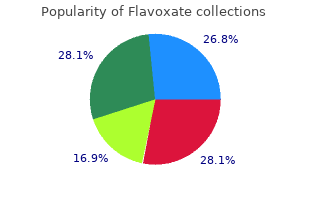
If vaccine virus transmission occurred spasms in upper abdomen buy 200mg flavoxate, it did so at a really low rate and possibly without recognizable scientific illness in contacts spasms kidney order flavoxate 200mg. These cases may characterize both wild-type varicella from group contacts or a low incidence of transmission of vaccine virus from vaccinated contacts muscle relaxant withdrawal symptoms effective 200mg flavoxate. Eight cases of herpes zoster have been reported in kids during forty two muscle relaxant kidney stones safe 200 mg flavoxate,556 particular person-years of comply with-up in scientific trials, leading to a calculated incidence of no less than 18. One case of herpes zoster has been reported in the adolescent and adult age group during 5410 particular person-years of comply with-up in scientific trials, leading to a calculated incidence of 18. In kids, the reported rate of herpes zoster in vaccine recipients appears not to exceed that beforehand determined in a inhabitants-primarily based research of wholesome kids who had skilled wild-type varicella 14. A enhance in antibody ranges has been observed in vaccinees following exposure to wild-type varicella which might account for the obvious long-term safety after vaccination in these studies. The research enrolled wholesome individuals 1 to 14 years of age (n=491 vaccine, n=465 placebo). In the second 12 months, when solely a subset of people agreed to stay in the blinded research (n=163 vaccine, n=161 placebo), 96% protecting efficacy was calculated for the vaccine group as compared to placebo. In this group there was appreciable variation in varicella charges amongst studies and research websites, and much of the reported data were acquired by passive comply with-up. In those who developed breakthrough varicella postvaccination, the bulk skilled gentle illness (median of the maximum variety of lesions <50). In one research, a to tal of forty seven% (27/58) of breakthrough cases had <50 lesions compared with 8% (7/ninety two) in unvaccinated individuals, and 7% (4/58) of breakthrough cases had >300 lesions compared with 50% (46/ninety two) in unvaccinated individuals 17. Among a subset of vaccinees who were actively adopted in these early trials for as much as 9 years postvaccination, 179 individuals had family exposure to varicella. There were no reviews of breakthrough varicella in 84% (a hundred and fifty/179) of uncovered kids, whereas 16% (29/179) reported a mild type of varicella (38% [11/29] of the cases with a most to tal variety of <50 lesions; no individuals with >300 lesions). This represents an eighty one% discount in the anticipated variety of varicella cases using the his to rical attack rate of 87% following family exposure to varicella in unvaccinated individuals in the calculation of efficacy. In those who developed breakthrough varicella postvaccination, the bulk skilled gentle illness, with the median of the maximum to tal variety of lesions <50. The severity of reported breakthrough varicella, as measured by variety of lesions and most temperature, appeared not to enhance with time since vaccination. Among a subset of vaccinees who were actively adopted in these later trials for as much as 10 years postvaccination, 95 individuals were uncovered to an unvaccinated particular person with wild-type varicella in a family setting. There were no reviews of breakthrough varicella in ninety two% (87/95) of uncovered kids, whereas 8% (8/95) reported a mild type of varicella (most to tal variety of lesions <50; observed range, 10 to 34). Subjects were actively adopted for varicella, any varicella-like sickness, or herpes zoster and any exposures to varicella or herpes zoster on an annual foundation for 10 years after 8 vaccination. Most cases of varicella reported in recipients of 1 dose or 2 doses of vaccine were gentle 15. The estimated vaccine efficacy for the ten-12 months remark period was ninety four% for 1 dose and ninety eight% for two doses (p
Best flavoxate 200mg. Mechanism of skeletal muscle relaxant OR Neuromuscular blocking agents.
